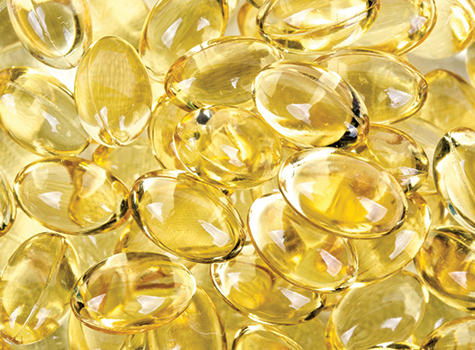
Vitamin D is also called the sunshine vitamin.
In recent years, Vitamin D deficiency has increased. A study published in Endocrine Society’s Journal of Clinical Endocrinology & Metabolism found that more than 80 percent of 200 hospitalized COVID patients had a vitamin D deficiency. Those patients recovered better after receiving a vitamin D prescription. So, what is Vitamin D and how much do we need?
It is mistakenly believed that we can get Vitamin D through sunlight. Actually, sunlight does not have Vitamin D. Our skin has an inactive form of Vitamin D or rather a precursor called 7-dehydrocholesterol. During exposure to sunlight, 7-dehydrocholesterol in the skin absorbs UV B radiation and is converted to provitamin D3 which in turn converts to Vitamin D3 or ergocalciferol.
Sun induced vitamin D synthesis is greatly influenced by season, time of day, latitude, altitude, air pollution, skin pigmentation, sunscreen use, passing through glass and plastic, and aging. Due to these not all of us are able to get enough Vitamin D through sunlight. Modern lifestyle habits such as staying indoors in buildings, applying sunscreen, and diet are all reasons why there is more Vitamin deficiency.
What exactly is Vitamin D?
Vitamin D is not just one chemical, but it has many forms. It is not just a nutrient but is also known as a prohormone. Technically, it is not even a vitamin.
Vitamin D, also known as calciferol, comprises a group of fat-soluble sterols. The two major forms are vitamin D2 and vitamin D3. Vitamin D2 (ergocalciferol) is largely human-made and/or added as a supplement to foods, whereas vitamin D3 (cholecalciferol) is synthesized in the human skin. Vitamin D obtained from sun exposure, foods, and supplements is biologically inert and must undergo two processes in the body for activation.
The first step happens in the liver, where calciferol is converted to 25-hydroxyvitamin D, or 25(OH)D. (This is what is measured by the blood test when you get your Vitamin D levels checked). However, 25(OH)D cannot work until it travels to the kidney. There it acquires a final pair of oxygen and hydrogen molecules to become 1,25 dihydroxyvitamin D, also known as 1,25(OH)2D, or calcitriol, and is the most active form of Vitamin D. The production of calcitrol in the kidneys is regulated by hormones. This also depends on serum calcium and phosphorus levels.
So as you can see, it’s quite a complicated process where multiple organs in the body are involved. Therefore, simply sitting in the sunlight or taking excess supplements is not the answer. You body needs to work correctly and your overall health is important in preventing Vitamin D deficiency.
Why is Vitamin D important?
Vitamin D has many important functions in the body.
• promotes calcium absorption in the gut
• maintains adequate serum calcium and phosphate levels to enable normal bone mineralization
• essential for bone growth and preventing osteoporosis
• helps with muscle contraction, and thus prevents muscle cramps and involuntary spasms
• reduces inflammation
• modulates cell growth which may play a role in preventing cancer (studies have found that Vitamin D can inhibit the development of tumors and slow the growth of existing tumors)
• modulates neuromuscular function which plays a role in preventing heart disease (since the heart is a large muscle)
• helps to keep arteries flexible and relaxed, which in turn helps to control high blood pressure.
• modulates glucose metabolism – Low vitamin D may affect beta cell function in the pancreas, insulin resistance, and inflammation, thus increasing risk of diabetes
• improves immune function – low levels of vitamin lowers the body’s immunity and increases risk of infections as studies have shown during the pandemic. There have also been many studies associating Vitamin D deficiency with autoimmune diseases
How much should we take as supplements?
Vitamin D is not naturally present in foods. Only a few foods such as eggs and fatty fish have some amount of vitamin D. Research is also showing that factory farming of animals and the diet they are fed has also affected the amounts of naturally occurring vitamin D. Majority of vitamin D available in foods is because of fortification, which means that synthetic Vitamin D is added to milk, yogurt and other foods.
We need to take supplements to get adequate vitamin D. Until 1997, the recommended dietary allowance (RDA) for vitamin D was 200 IU for all adults. Faced with growing evidence of vitamin D deficiencies in Americans, the RDA for 51- to 70-year-olds was increased to 400 IU, and to 600 IU for people older than 70. New research suggests taking 1,000 – 2000 IU per day for maintenance (if your levels are normal).
The normal range of vitamin D is measured as nanograms per milliliter (ng/mL). A normal level is considered anywhere between 30-100 ng/mL.
If your level is too low, you may be given a prescription dose of 50,000 units to be taken once a week. The general protocol is to take the prescription dose for 6-8 weeks, then lower to the maintenance dose of 2000 IU daily.
Vitamin D toxicity
Too much of anything is not a good thing. Excess amount of vitamin D can cause health issues. A 2010 study published in JAMA showed that intake of very high doses of vitamin D in older women was associated with more falls and fractures. Excess vitamin D has also been shown to increase risk of kidney stones, and also kidney failure. Excess vitamin D can cause elevated serum calcium levels which may cause digestive distress, such as vomiting, nausea, stomach pain, fatigue, dizziness, and confusion. vitamin D toxicity can have devastating health effects, which may not show up until months or even years after starting to take high doses.
Generally, it is not recommended to exceed the upper limit of safe intake, which is 4000 IU (100 micrograms) per day.
———-
Parul Kharod, MS, RD, LDN is a registered dietitian and licensed nutritionist and works as a Clinical Dietitian with Outpatient Nutrition Services at WakeMed Hospital in Cary and Raleigh. She can be reached at [email protected]
Posted: Monday, March 8, 2021



